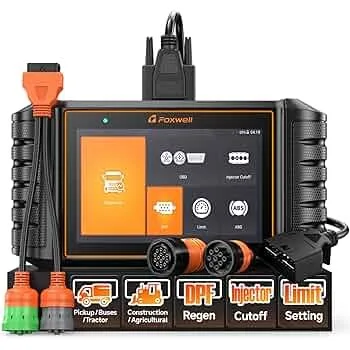Comprehensive Guide to Foxwell HD500 DPF Regeneration: Step-by-Step Operation and Common Precautions
Diesel engines are highly valued for their strength, durability, and fuel efficiency, especially in heavy-duty trucks and industrial vehicles. However, they produce soot and particulate matter that must be filtered out to meet emissions regulations. This is where the Diesel Particulate Filter (DPF) comes into play. Over time, soot accumulates inside the filter, reducing performance and fuel efficiency. To restore normal function, the DPF must undergo a process called regeneration, where trapped soot is burned off at high temperatures.
The Foxwell HD500 is a specialized heavy-duty truck DPF tool designed to perform and monitor DPF regeneration on a wide range of diesel vehicles. In this guide, we’ll explore how the HD500 simplifies the regeneration process, provide a detailed step-by-step operation walkthrough, discuss common issues and precautions, and offer compatibility tips for different vehicle models.
To learn more about the product itself, visit the Foxwell HD500 page, or explore the full range of diagnostic tools on the professional car diagnostic tool website.
Advantages of the Foxwell HD500 in DPF Regeneration
The Foxwell HD500 has become a preferred choice among technicians and fleet maintenance professionals due to its combination of versatility, precision, and ease of use. Below are its main advantages when it comes to diesel DPF regeneration.
1. Tailored for Heavy-Duty Vehicles
Unlike basic OBD2 scanners, the HD500 is designed specifically for heavy-duty trucks, buses, and equipment. It supports both 12V and 24V systems and communicates using standard heavy-duty protocols such as J1939, J1708, and J1587. This allows it to work with brands like Cummins, Caterpillar, Detroit, Paccar, International, Hino, and more.
2. Dedicated DPF Functions
The HD500 provides full DPF service capabilities—manual regeneration, soot load monitoring, DPF reset, and data logging. It can also trigger forced regenerations when automatic or passive regeneration fails, saving time and avoiding costly downtime.
3. Real-Time Monitoring
During regeneration, the tool allows you to view real-time data such as exhaust temperature, differential pressure, and soot accumulation percentage. This live feedback ensures the regeneration process is proceeding safely and effectively.
4. User-Friendly Interface
The HD500’s bright color display and intuitive menu structure make it suitable for technicians at all skill levels. Clear on-screen prompts guide the user through each regeneration step.
5. Regular Software Updates
Foxwell provides frequent updates to extend compatibility and improve performance. Updates can be downloaded easily via a computer or directly from Foxwell’s support portal.
6. Cost-Effective Alternative to OEM Tools
Compared to expensive dealer diagnostic systems, the HD500 offers powerful regeneration capabilities at a fraction of the cost, making it ideal for small workshops and fleet operators.
Step-by-Step Operation Guide for HD500 DPF Regeneration
Performing a DPF regeneration with the HD500 is straightforward. However, careful preparation is essential to ensure safety and successful completion. The following step-by-step guide outlines the typical process.
Step 1: Preparation
- Make sure the engine is warmed up to its normal operating temperature.
- Check that the fuel level is adequate (at least ¼ tank).
- Verify all engine fluids are within the correct range.
- Ensure there are no active fault codes related to the DPF, sensors i.e. MAP Sensor , Crankshaft Sensor etc. or exhaust system.
- Park the vehicle in a well-ventilated area with no flammable materials nearby.
Step 2: Connect the HD500
- Connect the diagnostic cable to the truck’s data port (6-pin, 9-pin, or 16-pin connector).
- Power on the HD500; it will automatically recognize the vehicle communication protocol.
Step 3: Select the Vehicle System
- From the main menu, choose the appropriate manufacturer and system (usually “Engine Control” or “Aftertreatment”).
- Navigate to the DPF Service or Regeneration
Step 4: Check Preconditions
- The HD500 will verify parameters such as coolant temperature, engine speed, and exhaust temperature.
- If any condition is not met, the tool will display a warning. Address the issue before proceeding.
Step 5: Initiate Regeneration
- Once conditions are met, confirm to start the regeneration process.
- The engine RPM will rise automatically, and the tool will begin burning off the accumulated soot inside the DPF.
Step 6: Monitor the Process
- Observe real-time data, including:
- Exhaust temperature before and after DPF
- Differential pressure across the DPF
- Soot load percentage
- The regeneration process typically takes 15–30 minutes, depending on the soot load.
Step 7: Completion and Verification
- When regeneration is complete, the HD500 will display a success message.
- Check the DPF pressure and soot readings again to confirm they have decreased.
- Clear any remaining DPF-related codes and perform a short road test to verify performance.
Common Issues, Precautions, and Solutions
Even with the best tools, DPF regeneration can sometimes present challenges. The following table summarizes common issues, their possible causes, and recommended solutions when using the HD500.
| Issue | Possible Cause | Solution / Precaution |
| Regeneration will not start | Coolant temperature too low, low fuel, active fault codes | Warm up engine, refuel, clear fault codes |
| Regeneration interrupted | Communication lost or operator stopped process | Ensure stable connection and avoid interrupting |
| DPF pressure does not decrease | Filter heavily loaded or damaged | Consider manual cleaning or replacement |
| Excessive exhaust temperature | Overheating or airflow restriction | Stop process, inspect for blocked exhaust or faulty sensors |
| Continuous regeneration requests | Faulty differential pressure sensor | Replace sensor and reset DPF data |
| Unusual noise or smoke during regen | Incomplete combustion or fuel imbalance | Check injector system and perform diagnostic scan |
| Communication error | Incorrect adapter or connector | Verify correct port and cable compatibility |
General Precautions
- Always perform regeneration in an open, well-ventilated area.
- Keep at least 1.5 meters (5 feet) of clearance from the exhaust outlet.
- Do not leave the vehicle unattended during regeneration.
- Avoid forced regeneration unless automatic regeneration has failed.
- Allow the DPF to cool before performing any mechanical inspection.
- Never disconnect cables or turn off ignition during the process.
Following these precautions helps prevent damage to the DPF system and ensures technician safety.
Compatibility Tips for Common Vehicle Models
The HD500 is widely compatible, but understanding which systems it supports can make your workflow smoother. Below is a general compatibility overview for major truck and engine brands.
| Vehicle/Engine Brand | DPF Function Support | Notes / Compatibility Tips |
| Cummins | Full support for most ISX, ISB, ISC, ISL engines | Ensure ECU communication protocol is J1939 |
| Caterpillar | Full support including regen and DPF reset | Use proper 9-pin adapter for older models |
| Detroit Diesel | Supports regen and fault code reading | Some DD13/DD15 ECUs require firmware update |
| Paccar / Kenworth / Peterbilt | Supported via J1939 connection | Check soot load before forced regen |
| International (Navistar) | Compatible with most MaxxForce engines | Verify engine is above operating temperature |
| Hino | Supports regen and data monitoring | May require manual selection of ECU |
| Volvo / Mack | Partial regen support on some D13/MP8 engines | Functionality varies by model year |
| Isuzu | Limited support | Check specific model before use |
Additional Compatibility Tips
- Always update the HD500 software before use. Regular updates expand coverage for newer trucks and engines.
- Test communication first by reading live data or system information before initiating regeneration.
- Use manufacturer-specific adapters to ensure reliable data transfer.
- Consult Foxwell’s compatibility chart or contact support if unsure about a specific model.
Why Choose the Foxwell HD500 for Diesel DPF Regeneration
The Foxwell HD500 stands out as an all-in-one diagnostic and DPF solution for heavy-duty vehicles. Its built-in DPF regeneration function eliminates the need for multiple tools, while its robust compatibility and real-time data monitoring make it indispensable for fleet operators and repair shops.
Key benefits recap:
- Supports all major diesel engine manufacturers
- Provides real-time temperature and pressure monitoring
- Enables both automatic and manual regeneration
- Compact, easy to use, and affordable
- Backed by Foxwell’s regular updates and customer support
By using the HD500, technicians can reduce downtime, prevent costly DPF replacements, and keep vehicles operating efficiently under strict emission standards.
Conclusion
A properly functioning DPF system is essential for maintaining engine efficiency, emission compliance, and overall vehicle longevity. The Foxwell HD500 simplifies the complex process of DPF maintenance by offering an intuitive, reliable, and cost-effective solution for diesel DPF regeneration across a wide range of vehicles. Its specialized software, real-time monitoring, and compatibility make it one of the most capable heavy duty truck DPF tools available on the market.
For those maintaining fleets or working in diesel service workshops, the HD500 offers the perfect balance of performance, safety, and affordability. It not only performs DPF regenerations efficiently but also provides comprehensive diagnostics that help identify and prevent potential issues before they escalate.






